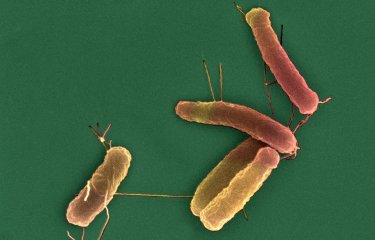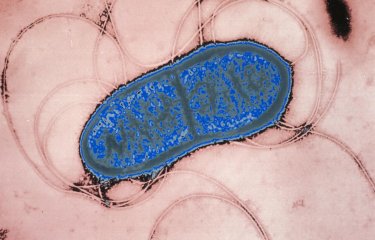Enterobacteriaceae, including Escherichia coli, become resistant to carbapenems – a class of antibiotics that are usually effective against the most resistant infections. To determine whether this form of resistance is likely to spread easily among the population, scientists from the Institut Pasteur, Paris Public Hospital Network (AP-HP), Paris Saclay University and the CNRS, together with the French National Reference Center for Antibiotic Resistance laboratory at Bicêtre Hospital (AP-HP), decided to decipher the various scenarios for carbapenemase gene acquisition in E. coli. They showed that acquisition of these resistance genes generally requires many preliminary steps, particularly specific mutations, which may constrain their emergence and spread. Their research was published in Genome Medicine on January 20, 2020.
Carbapenems are particularly potent antibiotics to fight the most tenacious bacteria and infections. But, over the last 20 years, some bacteria – such as enterobacteriaceae – have found ways to effectively resist these broad-spectrum antibiotics. How? By producing an enzyme (a carbapenemase) with the ability to cleave and inactivate carbapenems. "Carbapenem-resistant gram-negative bacteria are particularly feared by WHO, which has classified them as "critical" in its priority pathogens list for research and development of new antibiotics", begins Philippe Glaser, Head of the Institut Pasteur/CNRS Ecology and Evolution of Antibiotic Resistance Unit.
Strains of Escherichia coli are among the carbapenemase-producing enterobacteriaceae. They are responsible for urinary tract infections, septicemia and meningitis in particular, and their possible spread among the population is a major public health concern. This is why Philippe Glaser's team worked with Thierry Naas's team from Bicêtre Hospital (AP-HP) to shed light on factors contributing to the emergence and spread of resistant isolates.
To understand how E. coli bacteria acquire a carbapenemase gene, and become resistant to carbapenems, the scientists sequenced the genome of isolates received by the French National Reference Center for Antibiotic Resistance laboratory at Bicêtre Hospital (AP-HP) and retrieved genomic sequences available online in public databases to get a global view of the situation. In total, over 12,000 strains were analyzed. "Thanks to various IT and statistical methods, we have identified the events (presence of resistance genes and mutations) that may facilitate the acquisition of a carbapenemase gene in E. coli, and we have discovered different scenarios that lead to the emergence of carbapenem-resistance", explains Philippe Glaser.
The findings show that, although acquisition of a carbapenemase gene can be sporadic in some E. coli lineages, it often occurs in existing multiple-antibiotic-resistant strains and following specific mutations that reduce bacterial sensitivity to beta-lactams – a family of antibiotics that includes penicillin derivatives and carbapenems. "Acquisition of these resistance genes, which is a step-by-step process, is therefore rather rare and complicated, sums up the scientist. It limits the spread of carbapenem-resistant E. coli strains among the population but the emergence of high-risk multidrug-resistant strains that spread easily is a possibility."
The scientists describe another rather reassuring finding – the E. coli ST131 pandemic lineage, which is today the most widespread lineage resistant to many beta-lactams in the world, does not contain the mutations that precede acquisition of the carbapenemase gene. In other words, these bacteria do not currently show the predisposition to become carbapenem-resistant. Finally, the scientists have shown that the mutations likely to make the bacteria less sensitive to antibiotics could be exchanged between strains, just like resistance genes.
"Although our research findings might seem fairly reassuring regarding the spread of E. coli-resistant strains, they also show that some beta-lactams may help to select carbapenem-resistant strains. There is also a risk of emergence of multidrug-resistant strains that are able to spread among the population. This must therefore be taken into account when using antibiotics, and during the monitoring conducted by the French National Reference Center, in partnership with Santé Publique France", concludes Philippe Glaser.
Source
Stepwise evolution and convergent recombination underlie the global dissemination of carbapenemase-producing Escherichia coli, Genome Medicine, January 20, 2020
1,2Rafael PATIÑO-NAVARRETE, 1,2Isabelle ROSINSKI-CHUPIN$, 1,2Nicolas CABANEL,
1,3,4,5Lauraine GAUTHIER, 1,5Julie TAKISSIAN, 6Jean-Yves MADEC, 7Monzer HAMZE,
1,4,5Remy A. BONNIN, 1,3,4,5Thierry NAAS$ and 1,2Philippe GLASER$.
$ Contributed equally
- Unité EERA, Institut Pasteur, APHP, Université Paris Saclay,
- UMR3525, CNRS, 28 rue du Dr Roux, 75015, Paris, France;
- EA7361 Faculty of Medicine of University Paris-Sud;
- Department of Bacteriology-Hygiene, Bicêtre Hospital, APHP,
- Associated French National Reference Center for Antibiotic Resistance, Le Kremlin-Bicêtre, France;
- Université de Lyon - Agence Nationale de Sécurité Sanitaire (ANSES), Unité Antibiorésistance et Virulence Bactériennes, Lyon, France.
- Laboratoire Microbiologie Santé et Environnement (LMSE), Ecole Doctorale des Sciences et de Technologie, Faculté de Santé Publique, Université Libanaise, Tripoli, Lebanon.





